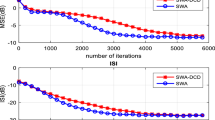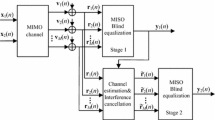Abstract
Blind equalization is a technique for adaptive equalization of a communication channel without the aid of the usual training sequence. Although the Constant Modulus Algorithm (CMA) is one of the most popular adaptive blind equalization algorithms, it suffers from slow convergence rate. A novel enhanced blind equalization technique based on a supervised CMA (S-CMA) is proposed in this paper. The technique is employed to initialize the coefficients of a linear transversal equalizer (LTE) filter in order to provide a fast startup for blind training. It also presents a computational study and simulation results of this newly proposed algorithm compared to other CMA techniques such as conventional CMA, Normalized CMA (N-CMA) and Modified CMA (M-CMA). The simulation results have demonstrated that the proposed algorithm has considerably better performance than others.
Similar content being viewed by others
References
Godard D. N. (1980) Self recovering equalization and carrier tracking in two dimensional data communication systems. IEEE Transactions on Communications 28(11): 1867–1875
Treichler J. R., Agee B. G. (1983) A new approach to multipath correction of constant modulus signals. IEEE Transactions on Acoustics, Speech, Signal Process ASSP-28: 459–472
Schirtzinger, T., et al.(1985). A comparison of three algorithms for blind equalization based on the constant modulus error criterion. In Proceedings of the IEEE ICASSP, pp. 1049–1052.
Weerackody, V., & Kassam, S. A., (1991). Variable step size blind adaptive equalization algorithms. IEEE International Symposium on Circuits and Systems, pp. 718–721.
Jones, D. L. (1996). A normalized constant modulus algorithm. In IEEE Conference Record of the Twenty-Ninth Asilomar Conference on Signals, Systems and Computers (Vol. 1, pp. 694–697).
Chahed, I., et al. (2004). Blind decision feedback equalizer based on high order MCMA. In Canadian Conference on Electrical and Computer Engineering (Vol. 4, pp. 2111–2114).
De Castro, F. C. C., et al. (2001). Concurrent blind deconvolution for channel equalization. In Proceedings of the ICC, pp. II-366–II-371.
Chen S. (2003) Low complexity concurrent constant modulus algorithm and soft decision directed scheme for blind equalization. IEE Proceedings of Visual Image Signal Proces 150: 312–320
Tong L. et al (1997) Channel-surfing re-initialization for the constant modulus algorithm. IEEE Signal Processing Letters 4(3): 85–87
Evans, S., et al. (1997). Adaptive channel surfing re-initialization of the constant modulus algorithm. In Thirty-First Asilomar Conference on Signals, Systems and Computers (Vol. 1, pp. 823–827).
Baykal B. (2004) Blind channel estimation via combining autocorrelation and blind phase estimation. IEEE Transactions On Circuits and Systems-I: Regular Papers 51(6): 1125–1131
Ying, R., Xu, G., & Liu, R. (2004). Decision feedback for autocorrelation matching anti-jamming filter, CAS 2004. IEEE 6th CAS Symposium on Emerging Technologies: Mobile and Wireless Communication, Shanghai, China (pp. 33–36).
Nawaz R., Chambers J. A. (2004) Blind adaptive channel shortening by single lag autocorrelation minimization. IEE Electronic Letters 40(25): 1609–1610
Luo, H., & Liu, R.-W. (2003). A closed form solution to blind MIMO FIR channel equalization for wireless communication systems based on autocorrelation matching. In Proceedings of the IEEE ICASSP (pp. IV-293–IV-296).
Mai J., Sayed A. H. (2000) A feedback approach to the steady-state performance of fractionally spaced blind adaptive equalizers. IEEE Transactions on Signal Processing 48(1): 80–91
Yousef N. R., Sayed A. H. (2001) A unified approach to the steady-state and tracking analyses of adaptive filters. IEEE Transactions on Signal Processing 49(2): 314–324
Haykin S. (2002) Adaptive filter theory, 4th ed. Prentice Hall Inc, New Jersey
Nascimento V.H., Silva M.T.M. (2008) Stochastic stability analysis for the constant-modulus algorithm. IEEE Transactions on Signal Processing 56(10, Part 1): 4984–4989
Touzni A., Fijalkow I., Larimore M. G., Treichler J. R. (2001) A globally convergent approach for blind MIMO adaptive deconvolution. IEEE Transactions on Signal Processing 49(6): 1166–1178
Luo Y., Chambers J. A., Lambotharan S. (2000) Global convergence and mixing parameter selection in the cross correlation constant modulus algorithm for the multi user environment. IEE Proceedings-Visual Image Signal Processing 148(1): 9–20
Luo Y., Chambers J. A. (2002) Steady-state mean-square error analysis of the cross correlation and constant modulus algorithm in a MIMO convolutive system. IEE Proceedings-Visual Image Signal Processing 149(4): 196–203
Proakis J. G. (2001) Digital communications (4th ed.). McGraw-Hill Co, Singapore
Author information
Authors and Affiliations
Corresponding author
Rights and permissions
About this article
Cite this article
Özen, A., Kaya, I. & Soysal, B. A Supervised Constant Modulus Algorithm for Blind Equalization. Wireless Pers Commun 62, 151–166 (2012). https://doi.org/10.1007/s11277-010-0045-1
Published:
Issue Date:
DOI: https://doi.org/10.1007/s11277-010-0045-1




